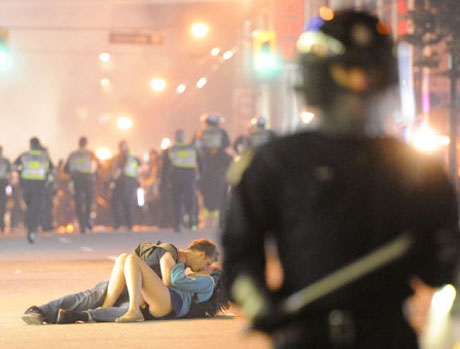As a fairly conservative person, I look at the first image and I'm instantly uncomfortable. There's an intimacy and rawness that seems far too private to be displayed to the public much less enlarged to that size. Yet, that's the fascinating thing about framing - it can completely change the context. With such a close up shot, the image clearly depicts bubbles on a body, but which part? The question itself insinuates other connotations. Yet, that's simply my arm - much more innocent than the picture would suggest. Despite taking the picture myself and knowing very logically what the image depicts, even my own mind jumps in a split second to assumptions, shock, judgement, and more. I remember during the Vancouver riots, a photograph blew up on the internet.
It seemed to be evidence of a couple kissing on the ground amidst the chaos surrounding them - they seemed at peace and in their own moment. Yet, from a different angle, the story told another story. In truth, the girl had fallen down during the stampede and was overwhelmed and crying. Her boyfriend was attempting to calm her down the best he could. This still fascinates me because it goes to show how there's a continuing cycle of how life and art affect one another. The public saw that photo, and perhaps you see my photo above, and we all make assumptions based on...imagery we have seen before. It's so interesting how over time images, colors, words, sounds, and so much more can collectively impact all of our thoughts.
In terms of photography, I wasn't willing to risk damaging my DSLR, so I used my iPhone 5 and the Camera+ app to take these two shots (and edit!). I'm constantly amazed at the power of our cell phones - I can't believe the amount of detail that can be captured.


